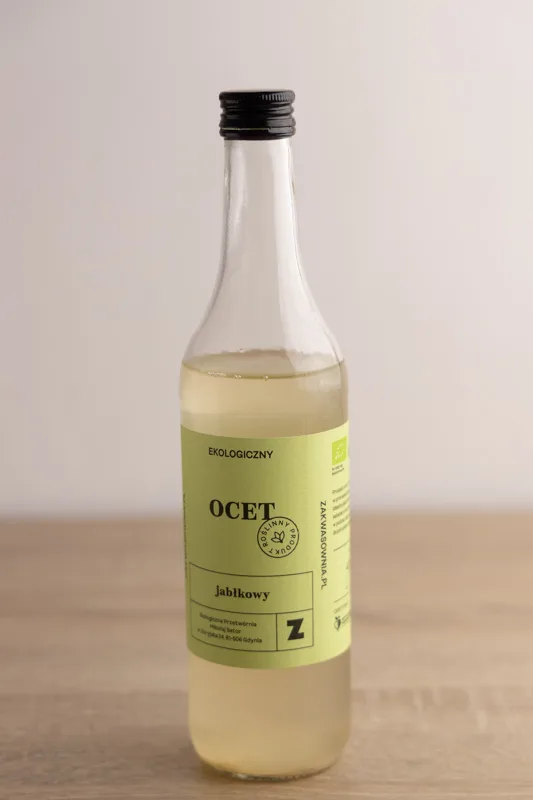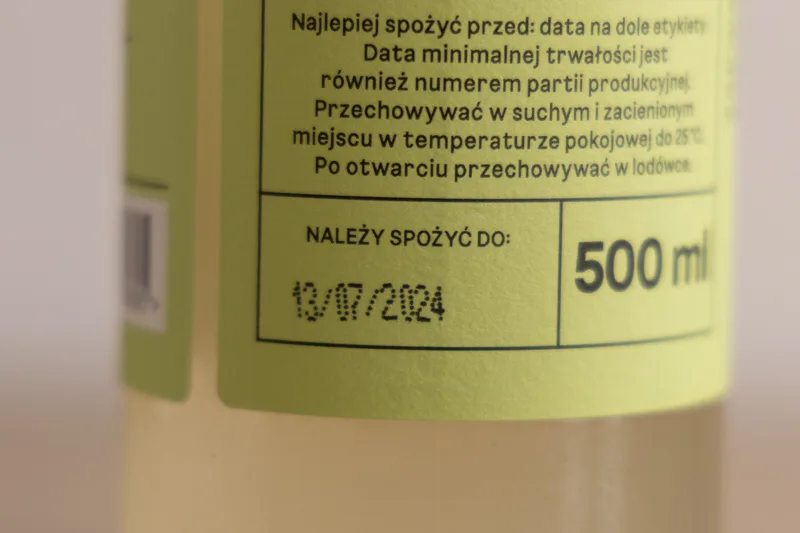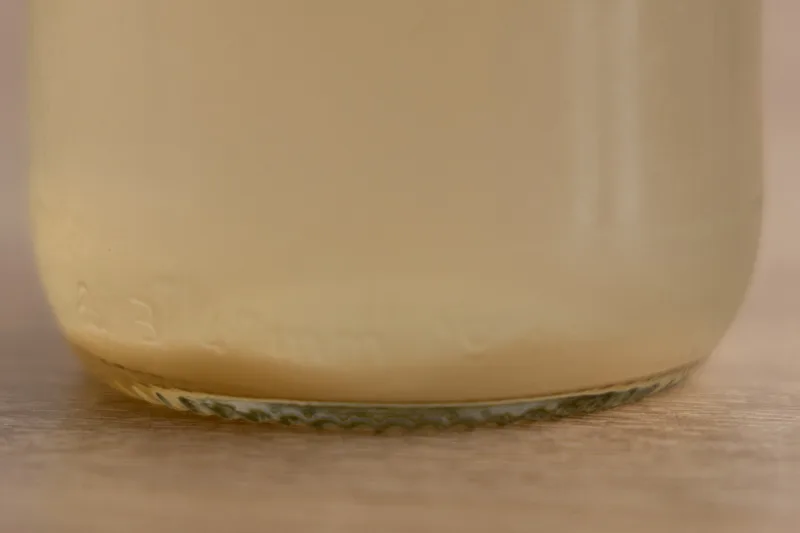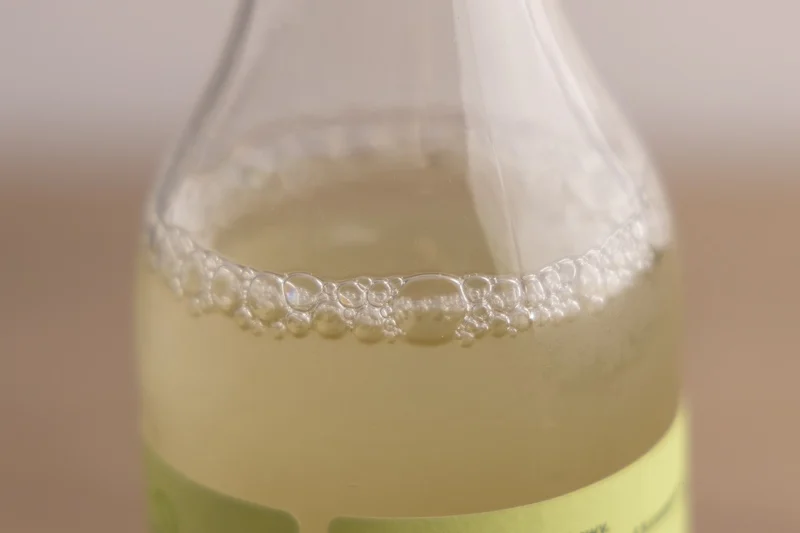In a Nutshell
- Shelf Life: Pretty much indefinite
- Spoilage: Signs include off smell, mold, and an altered taste
- Storage: Cool, dark place in a tightly sealed container
Apple cider vinegar has long been lauded for its potential health benefits, and its versatile uses extend from cooking to cleaning. With such a valuable ingredient in your pantry, it’s crucial to know how to store it properly to ensure the longest possible shelf life.
This article is your comprehensive guide to understanding the shelf life of apple cider vinegar, recognizing when it’s time to toss it (hint: most likely never), and learning the best storage methods to keep it fresh.
If you’re wondering “does apple cider vinegar go bad?” or want to learn about its shelf life or spoilage signs, read on.

How Long Does Apple Cider Vinegar Last?
Apple cider vinegar lasts pretty much indefinitely, both before and after opening, as long as you store it properly. That’s due to its highly acidic nature, thanks to which it’s self-preserving and doesn’t require refrigeration.
This property is shared with other types of vinegar, such as rice vinegar and distilled white vinegar. Like a fine wine, apple cider vinegar can last years if stored properly in a cool, dark place.
Expiration Date
Most bottles of vinegar come with a printed expiration date. That date is there mainly because people trust food products with “expiration dates” more than ones without.
That means you can ignore the expiration date without any negative consequences.
Does this mean that apple cider vinegar doesn’t ever go bad?
Not necessarily. In some rare cases, your ACV can spoil.
Let’s talk about those.

How to Tell If Apple Cider Vinegar Is Bad?
You can tell if apple cider vinegar is bad by checking for an off smell, mold growth, or an altered taste. While spoilage is extremely rare, you need to be aware of these signs to ensure your vinegar remains safe for consumption.
Again, neither of the signs below is common, and in most cases, your apple cider vinegar is perfectly fine, even if it’s a couple of years old bottle.
Off Smell
A key indicator of spoiled apple cider vinegar is an off or unpleasant smell. Fresh vinegar should have a strong, tangy aroma. If the smell is noticeably different or rancid, it might be time to discard the product.
Mold Growth
Mold growth is a clear sign that your apple cider vinegar has gone bad. It can appear as fuzzy, discolored spots on the surface of the vinegar or along the inside of the bottle.
If you spot any mold, it’s best to discard the entire bottle, as it may have contaminated the entire contents.
As I already mentioned, the acetic acid solution that is vinegar doesn’t easily grow mold. But if it gets contaminated, anything can happen.
Altered Taste
Lastly, an altered taste indicates that your apple cider vinegar might be past its prime.
If the flavor seems off or lacks the characteristic tangy zing, you should probably discard it. It doesn’t necessarily mean that your apple cider vinegar is spoiled, but if the vinegar’s taste has changed, it won’t be any good in your salad dressings or marinates.
This is similar to soy sauce and Tabasco sauce, where a lacking taste is a clear signal to open a fresh bottle.
Never drink apple cider vinegar straight. Instead, dilute it with two parts water to one part vinegar.
In conclusion, always pay attention to your apple cider vinegar’s smell, appearance, and taste to ensure it’s still safe and does its job in whatever you’re cooking.

Natural Changes in Apple Cider Vinegar: Harmless Things You Shouldn’t Worry About
Sometimes, apple cider vinegar may undergo natural changes that can be mistaken for spoilage. These changes are harmless and do not affect the quality or safety of the product.
Here are some common concerns and their explanations:
Sediment Formation
Over time, you might notice sediment forming at the bottom of your apple cider vinegar bottle.
This sediment, also known as the “mother,” is a natural byproduct of the fermentation process and consists of proteins, enzymes, and beneficial bacteria. It’s completely safe and even considered healthy by some.
Sediment also forms in Worcestershire sauce, and it’s not a cause for concern either.
Color Changes
You may notice that the color of your apple cider vinegar changes slightly over time. This is a natural process and does not imply that the product is spoiled.
Color changes can occur in other condiments, such as hot sauce known for browning.
Cloudiness
Another change that may cause worry is cloudiness in your apple cider vinegar. This cloudy appearance is due to the presence of the “mother” and is not a sign of spoilage.
In fact, many people seek out cloudy, unfiltered apple cider vinegar for its perceived health benefits.
Stored long enough, those clouds form discs and start looking really creepy, but they’re perfectly safe to consume. And if you’re like, “Nope, not gonna drink that,” you can filter out the mother using coffee filters and use the liquid.
Even if your vinegar has been filtered after the fermentation process, the “vinegar mother” can form on its own. It doesn’t mean the acetic acid solution is suddenly “bad” or “spoiled.”
Bubbles
Bubbles on the surface of ACV are perfectly normal. It works the same way in other fermented products.

In conclusion, it’s essential to differentiate between natural changes in apple cider vinegar and signs of spoilage. Sediment formation, color changes, and cloudiness are generally harmless and shouldn’t deter you from using this versatile and beneficial ingredient.
Does Apple Cider Vinegar Need to Be Refrigerated?
Apple cider vinegar does not require refrigeration, whether it’s unopened or opened. Storing it in a cool, dark place, like a pantry or cupboard, is typically sufficient to maintain its quality and shelf life.
Unlike condiments like mayonnaise and salad dressing, apple cider vinegar does not require refrigeration after opening due to its high acidity, inhibiting bacterial growth.
Storing apple cider vinegar at room temperature is perfectly acceptable, provided it’s kept in a cool, dark place to prevent exposure to heat and sunlight, which can affect the vinegar’s quality.
That said, you can store apple cider vinegar in the fridge if you like. Some brands even suggest refrigerating theirs after opening if it’s unfiltered vinegar.
How to Store Apple Cider Vinegar
To maximize the shelf life and maintain the quality of your apple cider vinegar, follow these storage guidelines:
- Keep it in a cool and dark place: Store the vinegar in a pantry or cupboard, away from direct sunlight or heat sources. This helps prevent changes in taste and color due to temperature fluctuations.
- Use an airtight container: Whether it’s the original bottle or another container, make sure it’s tightly sealed to minimize air exposure.
- Use clean utensils: If you need to pour or scoop the vinegar, always use clean utensils to prevent introducing contaminants. Cross-contamination is one of the few ways vinegar can actually go bad.
By storing apple cider vinegar correctly, you can enjoy its many uses and benefits for an extended period.